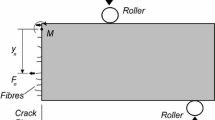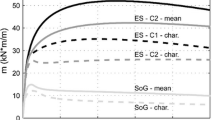Abstract
The results from small-scale laboratory tests of fibre reinforced concrete (FRC) usually show a high scatter. However, several studies indicate that the real scatter on the post-cracking response of the material reduces considerably with the increase of the size of the elements tested. Such observations highlights a possible contradiction in the design of FRC since the characteristic values estimated from small-scale tests might not be representative of large-scale structures. This could penalize the material, leading to higher fibre consumption, less competitive solutions and problems in the quality control. The main objective of the present study is to address this fundamental issue. The aim is to evaluate the scatter that is intrinsic to the FRC and how it is affected by the size of the element, the type of concrete, the type and content of fibre. For that, a novel numerical approach is proposed for the simulation of the material and its variability. Then, an extensive parametric study is conducted with more than 35,000 models, each one unique in terms of fibre distribution. Based on this analysis, equations are proposed to estimate the intrinsic scatter depending on several parameters. Finally, an alternative formulation is defined to estimate the characteristic value of the FRC considering the real structure in which it will be applied. The results derived from this study represent a contribution towards a more efficient design of structures and the reduction of the non-conformities in the quality control of the FRC.

















Similar content being viewed by others
References
Bencardino F, Rizzuti L, Spadea G, Swamyc RN (2013) Implications of test methodology on post-cracking and fracture behaviour of steel fibre reinforced concrete. Compos Part B 46:31–38
Blanco A, Pujadas P, de la Fuente A, Cavalaro S, Aguado A (2013) Application of constitutive models in European codes to RC–FRC. Constr Build Mater 40:246–259
Blanco A (2013) Characterization and modelling of SFRC elements. PhD Thesis Defended at the Universidad Politécnica de Cataluña. Barcelona, Spain
Giaccio G, Tobes J, Zerbino R (2008) Use of small beams to obtain design parameters of fibre reinforced concrete. Cem Concr Compos 30:297–306
di Prisco M, Plizzari G, Vandewalle L (2009) Fibre reinforced concrete: new design perspectives. Mater Struct 42:1261–1281
de la Fuente A, Escariz RC, Figueiredo AD, Aguado A (2013) Design of macro-synthetic fibre reinforced concrete pipes. Constr Build Mater 43:523–532
Hedebratt J (2012) Industrial Fibre Concrete Floors. TRITA-BKN. Bullletin 113:90
Vandewalle L, Van Rickstal F, Heirman G, Parmentier B (2008) On the round panel and 3-point bending tests. 7th RILEM international symposium on fibre reinforced concrete: design and applications—BEFIB, p 10
de la Fuente A (2011) Nueva metodología para el diseño de tubos de hormigón estructural”. PhD Thesis defended at the Universidad Politécnica de Cataluña. Barcelona, Spain
Kooiman AG (2000) Modelling steel fibre reinforced concrete for structural design”. PhD Thesis depended at TU Delft. Delft, The Netherlands
Bernard ES, Pircher M (2001) The influence of thickness on performance of fiber-reinforced concrete in a round determinate panel test. J Cem Concr Aggreg 23(1)
de la Fuente A, Escariz RC, Figueiredo AD, Molins C, Aguado A (2012) A new design method for steel fibre reinforced concrete pipes. Constr Build Mater 30:547–555
Pros A (2012) Numerical approach for modeling steel fiber reinforced concrete. PhD Thesis Defended at the Universidad Politécnica de Cataluña. Barcelona, Spain
Cunha V, Barros J, Sena-Cruzb J (2011) An integrated approach for modelling the tensile behaviour of steel fibre reinforced self-compacting concrete. Cem Concr Res 41(1):64–76
Pros A, Diez P, Molins C (2012) Modeling steel fiber concrete: numerical immersed boudery approach and a phenomenological mesomodel for concrete-fiber interaction. Int J Numer Methods Eng 90:65–86
Bazant Z, Novák D (2000) Probabilistic nonlocal theory for quasibrittle fracture initiation and size effect. I: theory. J Eng Mech 126:166–174
Bazant Z, Pang S, Vorechovský M, Novák D (2007) Energetic–statistical size effect simulated by SFEM with stratified sampling and crack band model. Int J Numer Meth Eng 71:1297–1320
Rilem TCQFS (2004) Quasibrittle fracture scaling and size effect—final report. Mater Struct 37:547–568
Molins C, Pros A, Díez P (2012) Numerical tool for modeling steel fiber reinforced concrete. RILEM international symposium on fibre reinforced concrete. Eighth RILEM international symposium on fibre reinforced concrete (BEFIB 2012): challenges and opportunities. Guimarães, Portugal, 19-21 September, 2012. Guimarães, Portugal, pp 1–9
Bentur A, Mindess S (2006) Fibre reinforced cementitious composites. 2nd edn, p 624
Naaman A, Nammur G, Alwan J, Najm H (1991) Fiber pullout and bond slip. I: analytical study. J Struct Eng 117(9):2769–2790
Stang H, Li Z, Shah S (1990) Pullout problem: stress versus fracture mechanical approach. J Eng Mech 116(10):2136–2150
Wang Y, Li VC, Backer S (1998) Modelling of fibre pull-out from a cement matrix. Int J Cem Compos Lightweight Concr 10(3):143–149
Laranjeira F (2010) Design-oriented constitutive model for steel fiber reinforced concrete. PhD Thesis Defended at the Universidad Politécnica de Cataluña. Barcelona, Spain
Laranjeira F, Molins C, Aguado A (2010) Predicting the pullout response of inclined straight steel fibers. Mater Struct 43(6):875–895
Laranjeira F, Molins C, Aguado A (2010) Predicting the pullout response of inclined hooked steel fibers. Cem Concr Res 40(10):1471–1487
Leung C, Shapiro N (1999) Optimal steel fiber strength for reinforcement of cementitious materials. J Mater Civ Eng 11(2):116–123
Robins P, Austin S, Jones P (2002) Pull-out behavior of hooked steel fibres. Mater Struct 35:434–442
Van Gysel A (2000) Studie van het uittrekgedrag van staalvezels ingebed in een cementgebonden matrix met toepassing op staalvezelbeton onderworpen aan buiging. PhD Thesis Defended at the Gent University. Gent, Belgium
Blanco A (2008) Durabilidad del hormigón con fibras de acero. Minor Thesis Defended at the Universidad Politécnica de Cataluña. Barcelona, Spain
Laranjeira F, Aguado A, Molins M, Grünewald S, Walraven J, Cavalaro S (2012) Framework to predict the orientation of fibers in FRC: a novel philosophy. Cem Concr Res 2(46):752–768
Grünewald S (2006) Performance-based design of self-compacting fibre reinforced concrete. PhD Thesis Defended at TU Delft. Delft, The Netherlands
Bar BIG, Lee MM, de Place Hansen EJ, Dupont D, Erdem E, Schaerlaekens B, Schnütgen B, Stang H, Vandewalle L (2003) Round-robin analysis of the RILEM TC 162-TDF beam-bending test: part 3—fibre distribution. Mater Struct 36:631–635
Bar BIG, Lee MM, de Place Hansen EJ, Dupont D, Erdem E, Schaerlaekens B, Schnütgen B, Stang H, Vandewalle L (2003) Round-robin analysis of the RILEM TC 162-TDF beam-bending test: part 1—test method evaluation. Mater Struct 36:609–620
Bar BIG, Lee MM, de Place Hansen EJ, Dupont D, Erdem E, Schaerlaekens B, Schnütgen B, Stang H, Vandewalle L (2003) Round-robin analysis of the RILEM TC 162-TDF beam-bending test: part 2—approximation of s from the CMOD response. Mater Struct 36:621–630
Author information
Authors and Affiliations
Corresponding author
Rights and permissions
About this article
Cite this article
Cavalaro, S.H.P., Aguado, A. Intrinsic scatter of FRC: an alternative philosophy to estimate characteristic values. Mater Struct 48, 3537–3555 (2015). https://doi.org/10.1617/s11527-014-0420-6
Received:
Accepted:
Published:
Issue Date:
DOI: https://doi.org/10.1617/s11527-014-0420-6




